Customer Experience
Customer Adoption: Benefits, Tools, Strategies, & Metrics
Article written by Jaby K J
Growth Marketer at SurveySparrow
17 min read
19 September 2025

Ever wondered about the significance of customer adoption?
Well, let’s try to understand it: customer adoption encapsulates the journey of attracting new customers when launching a new product into the market. Interestingly, this process isn’t confined solely to new product launches; it extends to penetrating new markets with existing products or introducing new offerings to current clientele.
In this guide, we’re exploring the full spectrum of customer adoption. From initial engagement strategies to the detailed tactics that ensure success, we’ll unpack the essentials of fostering a strong connection between your customers and your product or service.
Let’s go!
What is the Customer Adoption Process?
Customer adoption is the journey your customers embark on, from first hearing about your product to becoming loyal users and advocates. It’s about more than just making a sale; it’s about creating a lasting relationship. This journey is critical for businesses introducing new products or entering new markets and those aiming to deepen engagement with existing customers.
Moving from understanding the concept, let’s explore why this process is vital for your business’s growth and sustainability.
Why Customer Adoption Matters?
Have you ever wondered why some products become a part of daily life while others fade into obscurity? The secret lies in customer adoption. It’s not just about making a sale; it’s about igniting a relationship that grows over time. Let’s dive into why fostering this connection is indispensable for your business’s success.
Builds Brand Loyalty: A seamless adoption experience transforms first-time users into lifelong fans, embedding your brand into their daily lives and choices, fostering a deep-rooted loyalty that’s hard to shake.
Drives Revenue Growth: By mastering the art of customer adoption, you unlock new realms of profitability through upselling and cross-selling, turning satisfied customers into significant revenue streams.
Fosters a Feedback Loop: Engaging customers throughout the adoption process opens up invaluable channels of communication, where their insights become your roadmap for product refinement and innovation.
Secures Competitive Advantage: When you meet and exceed customer expectations, you distinguish your brand in a crowded marketplace, creating a unique value proposition that’s hard for competitors to replicate.
Lowers Churn Rate: Smooth customer adoption is the antidote to customer turnover; it ensures users not only stay but are happy to stay, reducing the churn rate and bolstering your business’s stability.
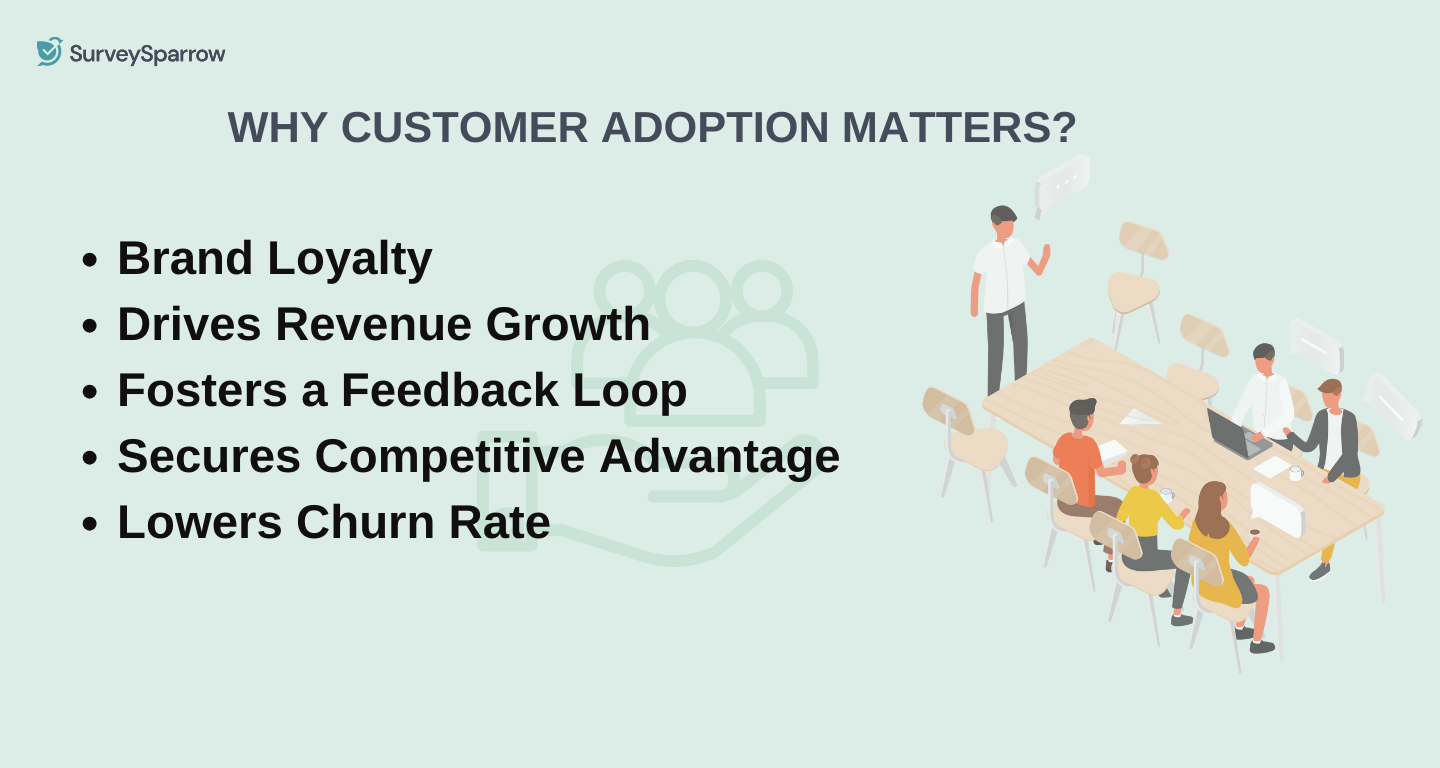
7 Steps in the Customer Adoption Process
The customer adoption process is a journey that potential customers go through before they become loyal users or advocates of a product or service. This journey is critical for businesses to understand and optimize, as it can significantly influence the success of their products or services in the market. The process is divided into several key stages, each representing a step closer to full adoption. Here’s a breakdown of these stages:
#1. Product Awareness
This is the initial stage where potential customers become aware of a product or service. Marketing and promotional efforts often play a significant role here, aiming to introduce the product to the target audience and generate interest.
#2. Product Interest
After learning about the product, potential customers enter the interest stage, showing curiosity and seeking more information. During this phase, they may visit the company’s website, follow its social media accounts, or read reviews and testimonials to learn more.
#3. Product Evaluation
At this point, consumers assess the product’s value and relevance to their needs. They compare it with competitors’ offerings, considering features, benefits, price, and quality. This stage is crucial, as the evaluation will determine whether they move forward in the adoption process.
#4. Product Trial
If the evaluation is favorable, potential customers may proceed to the trial stage, where they experience the product or service first-hand. This could involve a demo, a free trial period, or a sample. The trial experience is pivotal in shaping their perceptions and can significantly impact their decision to adopt fully.
#5. Adoption (Purchase)
When the trial meets or exceeds expectations, the customer purchases and fully adopts the product. This stage marks the transition from potential customers to actual customers, beginning their journey of using the product or service as part of their routine or lifestyle.
#6. Retention
Once a customer has adopted a product, the focus shifts to retaining them. Positive post-purchase experiences are essential to ensure customer satisfaction, loyalty, and the potential for repeat business. Efforts to retain customers can include excellent customer service, loyalty programs, and continuous engagement.
#7. Advocacy
The final stage occurs when satisfied customers advocate for the product or service. These customers make repeat purchases and recommend the product to others, share their positive experiences on social media, and provide valuable feedback. Advocacy is a powerful form of marketing, as personal recommendations carry significant weight in consumers’ purchasing decisions.
Understanding and facilitating a smooth transition through each stage can greatly enhance a business’s ability to attract, satisfy, and retain customers, ultimately leading to a stronger market position and sustained growth.
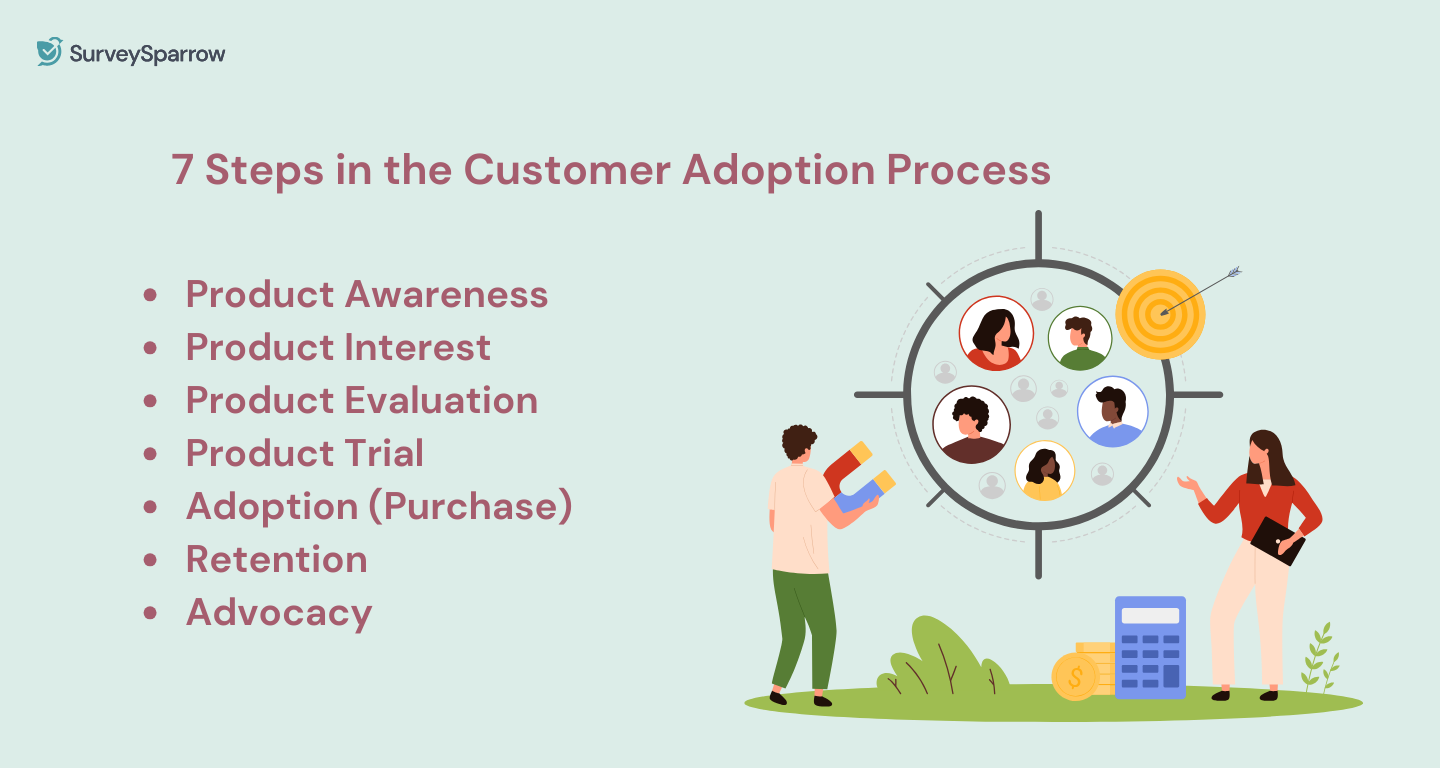
Top 9 Benefits of Customer Adoption
Customer adoption offers a range of benefits that can significantly contribute to a business’s sustained success and growth. Here are some of the key benefits:
1. Increased Customer Satisfaction: When customers fully adopt a product or service, they’re more likely to be satisfied with their purchase because they understand how to use it effectively and can fully realize its value. This satisfaction is crucial for building a loyal customer base.
2. Higher Customer Retention: Customers who have successfully adopted your product or service and see its value in their daily lives or businesses are likelier to stick with your brand over time. High customer retention rates are essential for long-term revenue stability and growth.
3. Enhanced Product Usage: Through effective customer adoption strategies, customers become more engaged with your product or service, increasing usage. This heightened engagement can result in more opportunities for upselling and cross-selling.
4. Reduced Support Costs: Well-executed customer adoption processes can help minimize the number of support requests by ensuring that customers understand how to use the product or service from the outset. This can lead to significant savings in support and service costs.
5. Valuable Feedback and Improvements: Engaged customers who have adopted your product are more likely to provide feedback. This feedback is invaluable for identifying product improvements, addressing issues, and innovating new features that meet customer needs.
6. Word-of-mouth referrals: Satisfied and engaged customers are more likely to recommend your product or service to others. Word-of-mouth referrals are a powerful marketing tool because they come with the trust and credibility of the referrer, leading to easier and more cost-effective customer acquisition.
7. Competitive Advantage: By focusing on customer adoption, you can differentiate your business from competitors. A strong emphasis on customer success can be a key selling point and competitive advantage in markets where products are similar.
8. Increased Lifetime Value: Customers who fully adopt and integrate your product or service into their workflows or lives are more likely to continue using it over a longer period. This increased lifetime value (LTV) is crucial for maximizing the return on investment in customer acquisition costs.
9. Better Resource Allocation: Understanding how customers adopt and use your product can provide insights into where to allocate resources more effectively, whether in product development, customer support, or marketing.
By prioritizing customer adoption, businesses can improve their relationship with current customers and set a strong foundation for growth and resilience in competitive markets.
What is the Customer Adoption Rate
The customer adoption rate is a crucial metric for businesses, indicating the speed and extent to which new customers are starting to use a product or service over a specific period. This rate is essential for understanding how effectively a business is attracting new users and converting them into active customers.
Customer adoption rate can be particularly insightful when launching a new product or entering a new market, as it helps gauge initial success and identify areas for improvement in marketing strategies, product offerings, or customer service.
How to Calculate Customer Adoption Rate
To calculate the customer adoption rate, divide the number of new customers who have started using the product or service within a certain timeframe by the total target market size, then multiply by 100 to get a percentage. This formula clearly shows your product’s penetration into the target market.
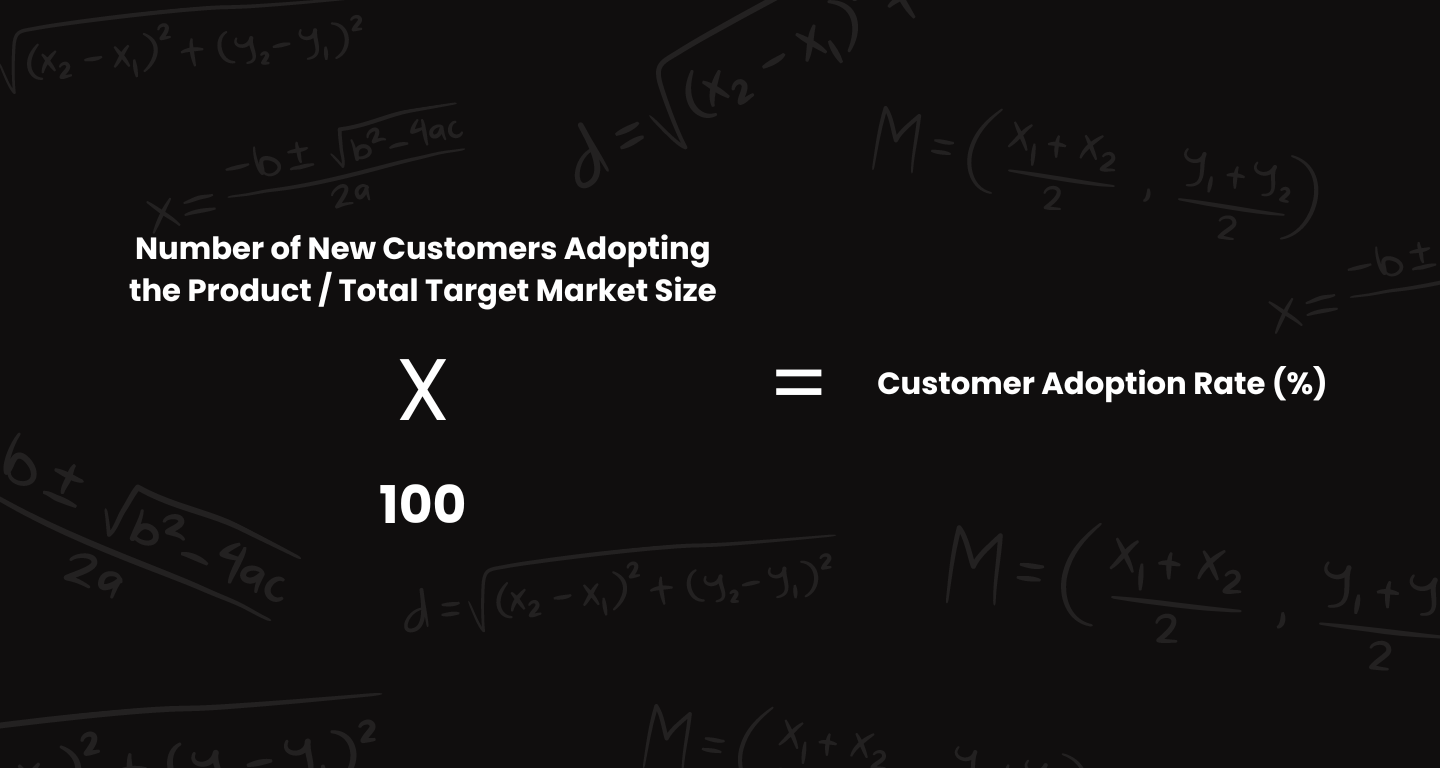
But measuring success doesn’t stop here. Let’s look at other key metrics that provide a fuller picture of customer adoption
5 Key Customer Adoption Metrics & KPIs
Measuring customer adoption effectively involves tracking various metrics and Key Performance Indicators (KPIs) that provide insights into how well customers integrate and use a product or service. Here are five key customer adoption metrics and KPIs:
1. Activation Rate
This metric measures the percentage of customers who take a specific, desired action within a certain period after signing up or purchasing. The specific action varies by product or service. Generally, it indicates the customer finds value, such as completing an onboarding process, making a first transaction, or using a key product feature. A high activation rate suggests that customers are successfully beginning to adopt the product.
2. Feature Usage
Tracking how often and extensively customers use various product features can provide insights into how deeply they have adopted it. Feature usage can be measured in several ways, such as the number of active users for a particular feature, frequency of use, and the diversity of features used. This metric helps identify which features drive value for users and which may need improvement.
3. Customer Retention Rate
Retention rate is crucial for understanding long-term adoption and satisfaction. It measures the percentage of customers who continue to use the product or service over time, typically calculated monthly or annually. High retention rates indicate successful customer adoption and satisfaction, whereas low retention rates may signal problems with the product or its adoption process.
4. Customer Effort Score (CES)
The Customer Effort Score is a composite metric that quantifies how engaged customers are with a product or service. It can include factors like login frequency, time spent with the product, feature usage, and interaction with support or community forums. Companies often develop their own CES formula based on what engagement looks like for their specific product. This score helps businesses understand overall adoption and engagement levels.
Suggested Read: Customer Effort Score! Hey, What’s that New Jargon?
5. Net Promoter Score (NPS)
While NPS is traditionally seen as a measure of customer satisfaction and loyalty, it can also serve as an indirect adoption metric.
NPS is calculated based on responses to the question, “How likely are you to recommend our product/service to a friend or colleague?” on a scale from 0 to 10.
Customers who fully adopt and find value in a product are likelier to be promoters (scoring 9-10). Monitoring NPS over time can provide insights into how adoption efforts impact customer satisfaction and advocacy.
Together, these metrics provide a comprehensive view of how well customers are adopting a product or service, enabling businesses to make informed decisions to improve the customer experience, enhance product features, and ultimately drive growth.
Access this free NPS Survey Template here.
NPS Survey Template
Use This Template
Wait, is there a tool to help you leverage customer adoption correctly?
Absolutely, there is! I’m excited to introduce you to five powerful tools designed to enhance customer adoption effectively. Topping my list of favorites is SurveySparrow. Let’s dive into how these tools can revolutionize the way customers engage with your product or service.
5 Tools to Improve Customer Adoption
1. SurveySparrow
G2 Rating: 4.5 / 5 stars
Pricing:
- Forever free plan available
- Basic plan: $19 per month
- Basic features Business Plan:$79
- Advanced features Professional Plan:$249

Overview: Surveysparrow redefines the survey experience with its conversational approach, fostering higher engagement and richer insights.
Key Features:
- Conversational surveys that mimic real conversations, boosting respondent engagement
- Automated follow-up surveys based on respondent behavior, ensuring comprehensive feedback capture
- Advanced analytics and reporting tools for actionable insights and data-driven decision-making

Explore Deeper Customer Insights with SurveySparrow
A personalized walkthrough by our experts. No strings attached!
2. Typeform
G2 Rating: 4.5 / 5 stars
Pricing:
- Free option available.
- Basic: 29
- Plus: $59/month
- Business: $99/month

Overview: Typeform is a simple online survey software, that empowers businesses to gather feedback and make informed decisions.
Key Features:
- Versatile survey creation tools with customizable templates and diverse question types
- Seamless integration with popular productivity tools and CRM systems for streamlined data management
- Robust data analysis capabilities, including real-time reporting and trend analysis, for informed decision-making
3. Crazy Egg
G2 Rating: 4.4 / 5 stars
Pricing:
- Basic: $24/month
- Standard: $49/month
- Plus: $99/month
- Pro: $249/month
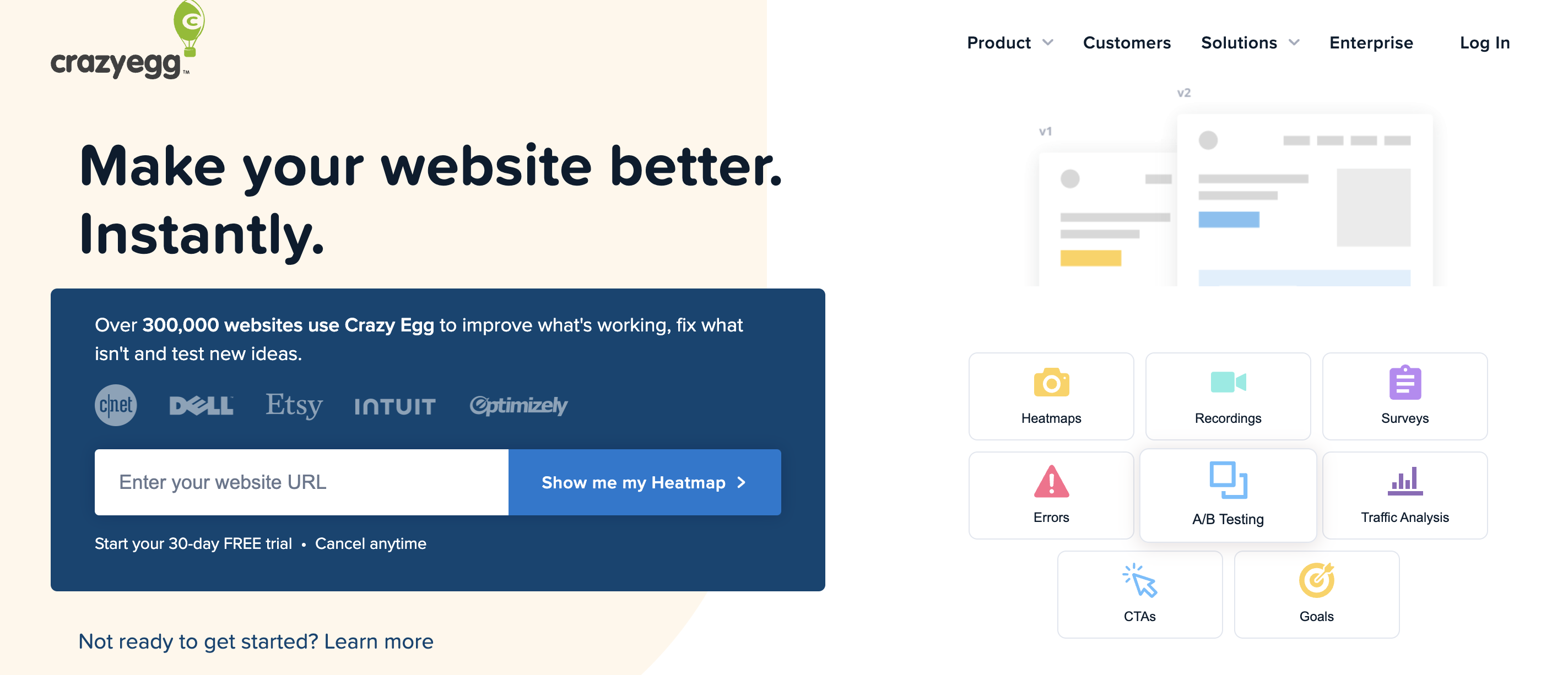
Overview: Crazy Egg offers a comprehensive user experience optimization platform, providing invaluable insights into website visitor behavior.
Key Features:
- Heatmaps and scroll maps for visually analyzing user interactions and identifying optimization opportunities
- A/B testing capabilities to experiment with different website elements and improve conversion rates
- User recordings for understanding individual user journeys and pinpointing pain points in the adoption process
4. ChurnZero
G2 Rating: 4.6 / 5 stars
Pricing: Quote-based, customized to business needs

Overview: ChurnZero is a customer success platform designed to reduce churn and maximize customer lifetime value.
Key Features:
Customer health scoring to identify at-risk accounts and prioritize proactive interventions
Automated workflows for nurturing customer relationships and driving product adoption
In-app messaging and personalized engagements to deliver timely support and guidance, fostering a seamless adoption experience
5. Whatfix
G2 Rating: 4.3 / 5 stars
Pricing:
Quote-based, customized to business needs
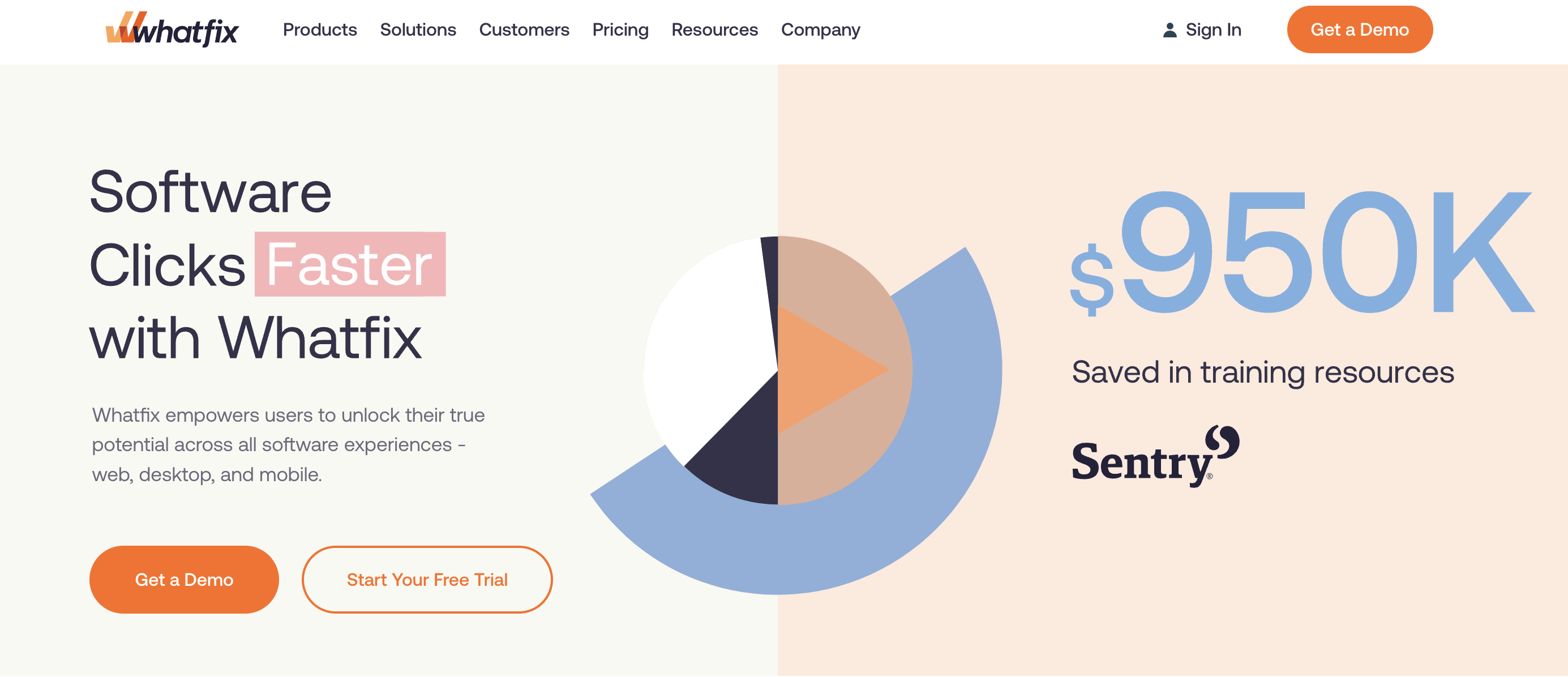
Overview: Whatfix is a digital adoption platform that empowers businesses to enhance customer adoption through on-demand support, in-app guidance, and actionable insights.
Key Features:
- No-code platform for creating personalized customer experiences with omnichannel content like product tours, task lists, and tooltips
- Advanced analytics to track and measure customer engagement with different product features, enabling data-driven decision-making
- Rapid content creation and curation tools for making in-app changes and publishing updates seamlessly, ensuring a frictionless adoption process
- Each tool offers unique features and pricing plans to cater to the diverse needs of businesses, providing the tools necessary to optimize customer adoption strategies and drive sustainable growth.
Read More: Voice of Customer Analysis: The Sooner You Do It, the Better.
The SurveySparrow Approach to Customer Adoption
SurveySparrow transforms customer adoption into a seamless journey with its state-of-the-art survey platform. Here’s how we align with each stage of customer adoption, ensuring a smooth transition from awareness to loyalty.
1. Product Awareness with Insightful Surveys
Creating awareness is the first step in the customer adoption process. SurveySparrow helps you gather market insights through targeted surveys, enabling you to understand and tap into your audience’s needs effectively. Our platform ensures that your first impression counts, laying a solid foundation for customer adoption.

2. Stoking Product Interest through Engagement
Once aware, potential customers must be nurtured to develop a keen interest in your product. SurveySparrow’s engaging survey formats, from chatbots to conversational forms, keep potential customers engaged and eager to learn more about what you offer.
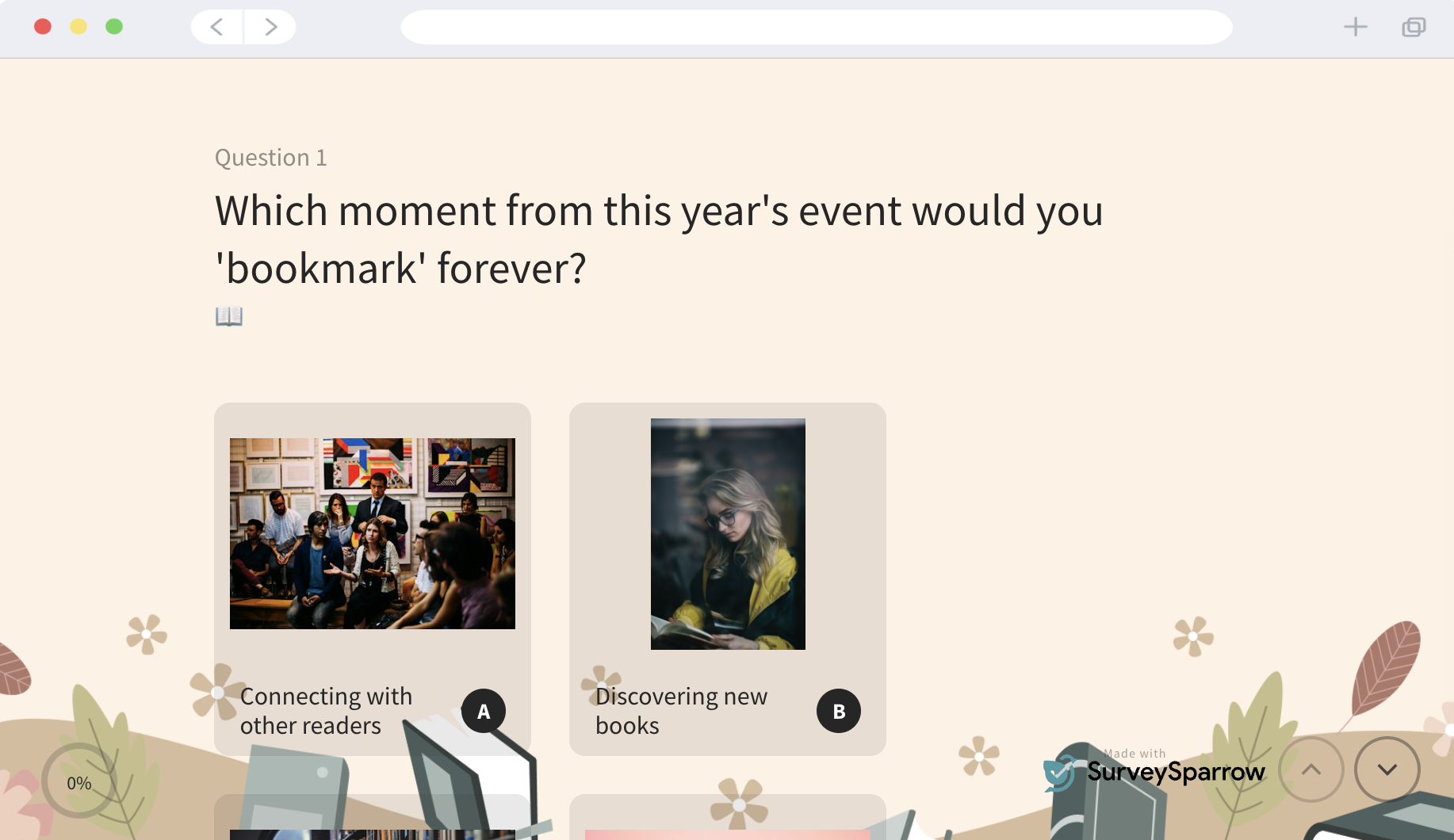
3. Facilitating Product Evaluation with Data
Customers weigh your product against their needs and other market offerings in the evaluation stage. SurveySparrow aids this process by providing tools to collect and analyze customer feedback, helping you present your product as the solution to their specific problems.
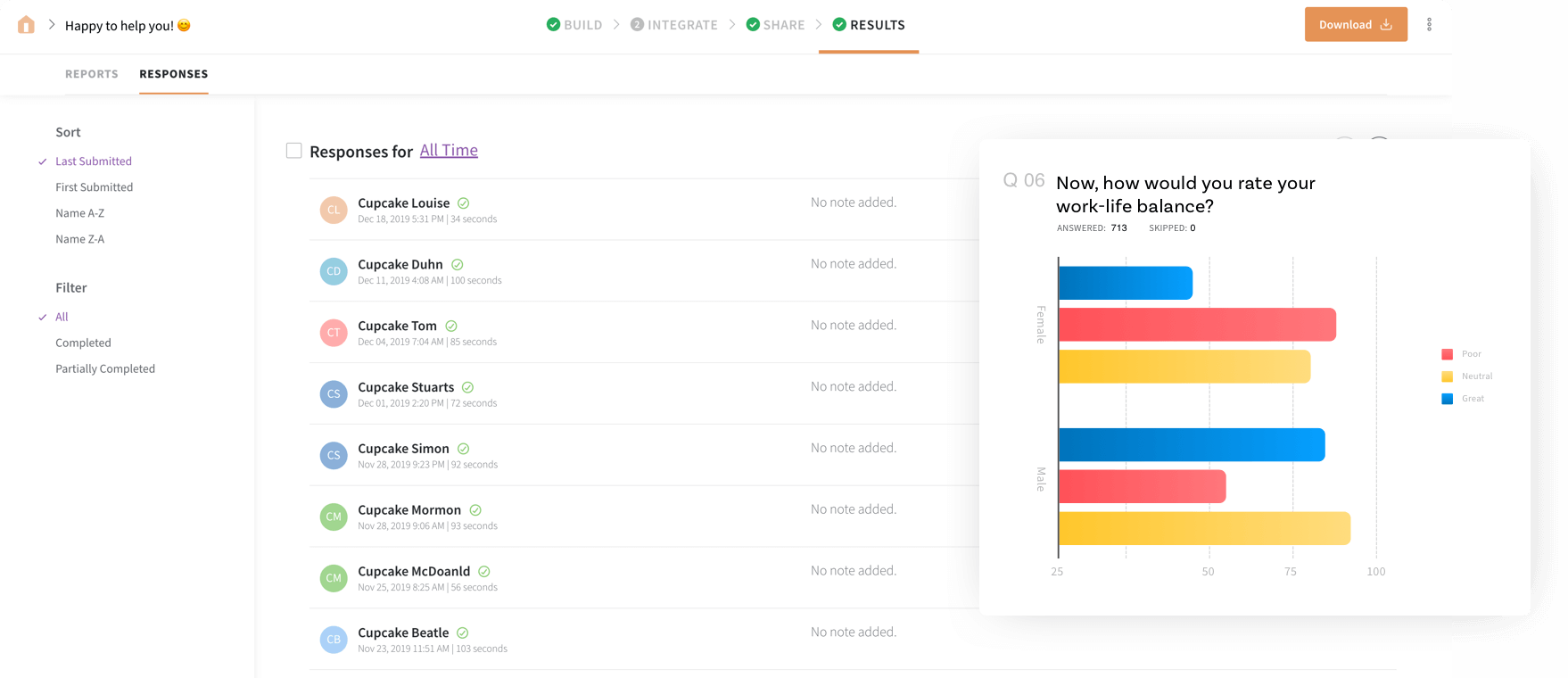
4. Encouraging Product Testing through Feedback Loops
SurveySparrow enables you to offer personalized experiences during the product testing phase. Our platform’s feedback loops allow for real-time adjustments and improvements, showcasing your product’s value and how it fits into the customer’s world.
5. Sealing Product Adoption with Continuous Support
Finally, SurveySparrow ensures that the adoption phase is as smooth as possible. Our survey tools help you keep the lines of communication open, offering continuous support and gathering insights to enhance user experience, thereby solidifying the customer’s decision to choose your product.


Explore Deeper Customer Insights with SurveySparrow
A personalized walkthrough by our experts. No strings attached!
Wrap Up!
That wraps up our discussion on customer adoption. I hope this blog has been informative for you.
Any questions? Feel free to ask—I’m here to help!
FAQ
1. Difference Between Customer Adoption and Customer Acquisition
Customer adoption and acquisition are two important concepts in business, particularly in marketing and sales strategies, but they refer to different stages and aspects of the customer lifecycle.
Customer Acquisition
Customer Acquisition refers to the process of gaining new customers. It encompasses all the strategies, marketing efforts, and activities aimed at attracting potential clients to a business’s products or services. The goal of customer acquisition is to increase the customer base by convincing potential customers to make a purchase or subscribe to a service.
Techniques for customer acquisition include advertising, promotions, content marketing, social media campaigns, and more. The focus is on generating awareness, interest, and engagement among potential customers.
Customer Adoption
Customer Adoption refers to the process by which new customers become familiar with and start using a product or service. It goes beyond the initial purchase, focusing on customer experience, satisfaction, and retention.
But what does this journey look like? Let’s map out your customers’ steps in the adoption process.

Make your customers feel heard. Turn feedback into loyalty with SurveySparrow's CX platform.
Jaby K J
Once chasing a half-cooked Ph.D. dream in Literature amidst the stacks of academia, Jaby has successfully pivoted to become a product marketer in the SaaS industry, leveraging a rich background in research and a deep understanding of creating compelling narratives.
Related Articles

Customer Experience
Mastering Customer Experience Analytics: Driving Business Success
9 MINUTES
6 July 2023
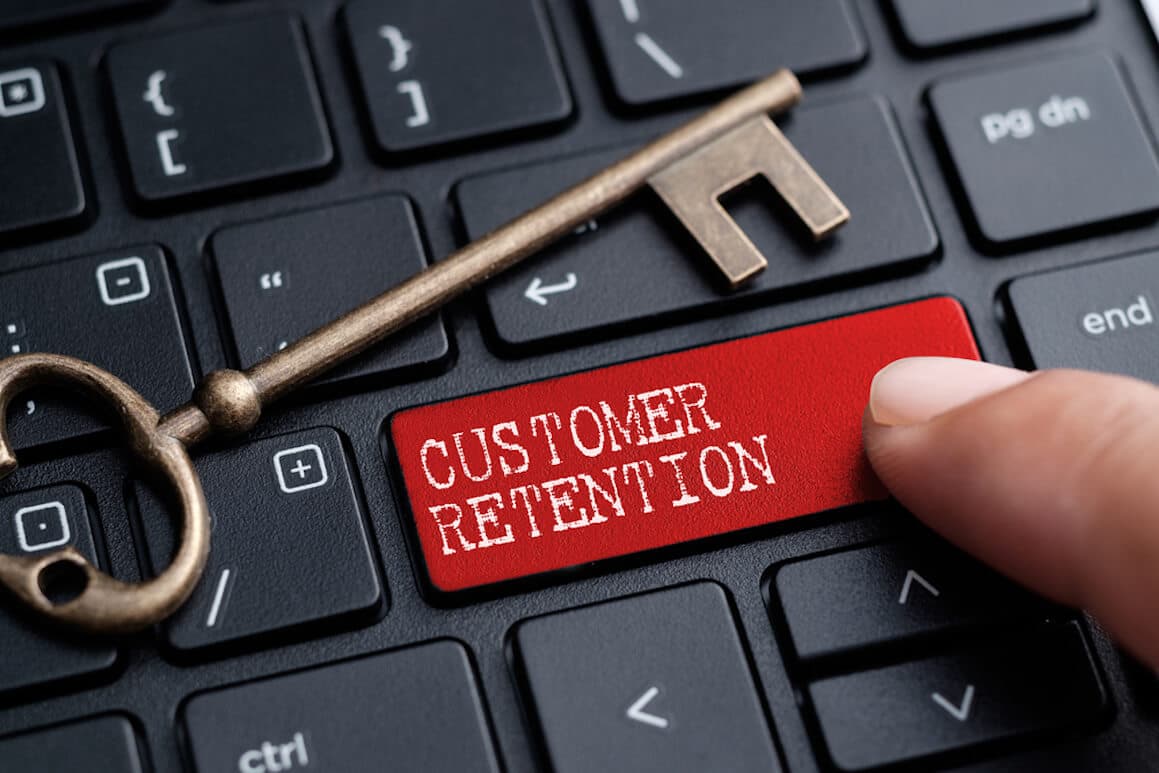
Customer Experience
The Average Customer Retention Rate By Industry
13 MINUTES
6 November 2018

Customer Experience
How to Improve Customer Experience? Here’re 8 Surefire Ways!
9 MINUTES
4 April 2018

Customer Experience
How to Build a Fail-Proof Customer Experience Strategy
16 MINUTES
26 October 2019
